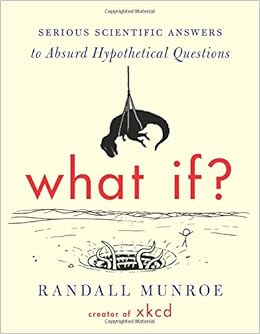 One of my favorite journeys is from the ridiculous to the sublime, and Randall Munroe’s entertaining and interesting new book, What If: Serious Scientific Answers to Absurd Hypothetical Questions is filled with and defined by such journeys.
One of my favorite journeys is from the ridiculous to the sublime, and Randall Munroe’s entertaining and interesting new book, What If: Serious Scientific Answers to Absurd Hypothetical Questions is filled with and defined by such journeys.
You may recognize Munroe from the excellent and popular online cartoon, xkcd, which employs stick figures, witty framing, and science jokes in service of a minimalist yet consistently sophisticated comic. The book captures the most popular questions coming from the What If? blog developed as an offshoot of xkcd.
What If? takes ridiculous scientific questions Munroe has received or encountered over the years and answers many of them — questions like:
- If every person on Earth aimed a laser pointer at the moon at the same time, would it change color?
- What would happen if you made a periodic table out of cube-shaped bricks, where each brick was made of the corresponding element?
- What if a glass of water was, all of a sudden, literally half empty?
- When — if ever — will the bandwidth of the Internet surpass that of FedEx?
- If you had a printed version of the whole of (say, the English) Wikipedia, how many printers would you need in order to keep up with the changes made to the live version?
There isn’t a dud question in the lot, and all are within the bounds promised on the book’s cover. Each response is clearly written and embroidered with witty and appropriate cartoons, many of which do the “a picture is worth a thousand words” heavy lifting you’d expect. His caption credit on the drawing of the person jumping off Mount Thor made me laugh out loud, as did the quadrant graph categorizing the quality of ideas.
Munroe’s drawing style is like his intellectual style — spare, efficient, and winning.
The journey from the absurd question to the relatively solid answer is always interesting. The answers embody how to break down a problem, use assumptions and data, model out an answer, and contemplate consequences. The explanations elucidate interesting natural, mathematical, and scientific phenomena — from how lightning works to why temperature in space is a fraught concept to how to calculate momentum for rockets turned inward on a submarine (for a superficially good reason, given the absurd circumstances created by one particular question).
Munroe also footnotes interestingly, such as in the response to “What if you had a mole of moles?” In pondering the problems one Avogadro of furry critters would generate, he neatly discovers something he’s “never noticed before — a cubic mile happens to be almost exactly 4/3π cubic kilometers, so a sphere with a radius of X kilometers has the same volume as a cube that’s X miles on each side.” He also nicely cartoons what nearly everyone thinks of a star-nosed mole upon seeing one.
To break up the book, Munroe dispenses with some questions quickly between major sections, using humor alone, such as:
Question: Is it possible to cry so much you dehydrate yourself? — Karl Wildermuth
Answer: . . . Karl, is everything OK?
Question: Would it be possible to get your teeth to such a cold temperature that they would shatter upon drinking a hot cup of coffee? — Shelby Hebert
Answer: Thank you, Shelby, for my new recurring nightmare.
To give you more of a flavor of what you’ll find in What If?, here is the first paragraph of his answer to the question, “What would happen if you tried to hit a baseball pitched at 90 percent the speed of light?”:
The answer turns out to be “a lot of things,” and they all happen very quickly, and it doesn’t end well for the batter (or the pitcher). I sat down with some physics books, a Nolan Ryan action figure, and a bunch of videotapes of nuclear tests and tried to sort it all out. What follows is my best guess at a nanosecond-by-nanosecond portrait.
If you’d like to know what happens in the 70 nanoseconds covered, and why baseball rules actually have relevance even in this extreme situation, you’ll need to read the book.
What If? is a great book for science geeks and general readers with an interest in scientific concepts. It’s funny, interesting, and unique, and it shows just how weird the inbox at xkcd must get at times.
Discussion
3 Thoughts on "Book Review: "What If?: Serious Scientific Answers to Absurd Hypothetical Questions" by Randall Munroe"
Note that the book is based on the “What If?” web-site, so anyone not sure if it’s their kind of thing can dip in to get a feel for it. For example, here is the answer to the mole of moles question.
Reblogged this on Paper Pills and commented:
Was this book written for me? (I wonder if it says anything about mermaids.)


